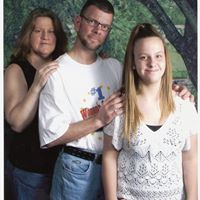Joseph J Vandenberg
age ~76
from West Covina, CA
- Also known as:
-
- Joseph Letty Vandenberg
- Joe J Vandenberg
- Joseph J Vandenerg
- Phone and address:
-
415 Lark Ellen Ave, West Covina, CA 91791
9095964766
Joseph Vandenberg Phones & Addresses
- 415 Lark Ellen Ave, West Covina, CA 91791 • 9095964766
- Kenosha, WI
- Duarte, CA
- Antioch, CA
- Fremont, CA
- Upland, CA
- 415 N Lark Ellen Ave, West Covina, CA 91791
Work
-
Position:Production Occupations
Education
-
Degree:High school graduate or higher
Us Patents
-
Lens System And Optoelectric Alignment Apparatus
view source -
US Patent:6519099, Feb 11, 2003
-
Filed:Sep 12, 2001
-
Appl. No.:09/953080
-
Inventors:Thomas H. Blair - San Jose CA 95119
Diana Ching Chen - Fremont CA 94539
Phillip J. Edwards - San Jose CA 95138
Siegfried Fleischer - Cupertino CA 95014
Bradley S. Levin - Palo Alto CA 94301
Oliver W. Northrup - Mountan View CA 94040
Michael M. OToole - San Jose CA 95138
Joseph John Vandenberg - West Covina CA 91791
Brett Matthew Zaborsky - San Jose CA 95112 -
International Classification:G02B 702
-
US Classification:359819, 359641
-
Abstract:The optoelectric alignment apparatus and lens system includes a glass ball positioned to receive light from a light source along an optical axis. A second lens is positioned to receive light from the glass ball and to supply the received light to a light receiving structure. The glass ball provides most of the optical power of the lens system so that the second lens provides only minor optical correction. The lens system is mounted by means of a molded plastic body that extends axially along the optical axis with the second lens molded into the body. The body includes a light inlet end and a light outlet in a surface lateral to the optical axis and defines a glass ball receiving cavity adjacent the light inlet end fixedly gripping the glass ball.
-
Optoelectric Alignment Apparatus
view source -
US Patent:6661951, Dec 9, 2003
-
Filed:Sep 12, 2001
-
Appl. No.:09/954919
-
Inventors:Thomas H. Blair - San Jose CA 95119
Diana Ching Chen - Fremont CA 94539
Phillip J. Edwards - San Jose CA 95138
Siegfried Fleischer - Cupertino CA 95014
Bradley S. Levin - Palo Alto CA 94301
Oliver W. Northrup - Mountain View CA 94040
Michael M. OToole - San Jose CA 95138
Joseph John Vandenberg - West Covina CA 91791
Brett Matthew Zaborsky - San Jose CA 95112 -
International Classification:G02B 632
-
US Classification:385 33, 385 74, 385 93
-
Abstract:Optical alignment apparatus includes a first element mounting a first lens and a light source and a second element mounting a second lens and a light receiving structure. The first lens is placed a first distance from the light source and is constructed to collimate light received from the light source. The first and second elements are mounted relative to each other to position the second lens a third distance from the first lens and to receive the collimated light from the first lens. The second lens is positioned a second distance from the light receiving structure to focus the collimated light on the light receiving structure. The first and second lens are constructed so that the first and second distances are dependent upon each other and the third distance is independent of the first and second distances.
-
Optoelectric Module
view source -
US Patent:6663296, Dec 16, 2003
-
Filed:Apr 23, 2002
-
Appl. No.:10/128102
-
Inventors:Thomas H. Blair - San Jose CA 95119
Phillip J. Edwards - San Jose CA 95138
Siegfried Fleischer - Cupertino CA 95014
Michael S. Lebby - Apache Junction AZ 85219
Bradley S. Levin - Palo Alto CA 94301
Oliver W Northrup - Mountain View CA 94040
Michael M. OToole - San Jose CA 95138
Joseph John Vandenberg - West Covina CA 91791 -
International Classification:G02B 600
-
US Classification:385 92, 385147
-
Abstract:An optoelectric module includes a cylindrical ferrule defining an optical axis and having a first end constructed to receive an optical fiber aligned along the optical axis. An optical element, including a lens, is engaged in the ferrule between the first and second ends and positioned to convey light along the optical axis. The second end of the ferrule is closed by a base. An optical component is mounted on the base so that light is directed through the lens from the optical component to the optical fiber or from the optical fiber to the optical component. Either a laser driver or an amplifier is mounted on the base and electrically connected to the optical component and external connections are made to the laser driver or the amplifier by electrical traces on a surface of the base, vias through the base, or flex leads mounted on the base.
-
Radially Symmetrical Optoelectric Module
view source -
US Patent:6758611, Jul 6, 2004
-
Filed:Jan 11, 2002
-
Appl. No.:10/044654
-
Inventors:Bradley S. Levin - Palo Alto CA 94301
Oliver W. Northrup - Mountain View CA 94040
Joseph John Vandenberg - West Covina CA 91791 -
International Classification:G02B 636
-
US Classification:385 93, 385 31, 385 49, 385 88, 385 89, 385 90, 385 91, 385 92
-
Abstract:A radially symmetrical optoelectric module includes a receptacle assembly with a symmetrical tubular ferrule and a first lens. The ferrule defines an axial opening extending along an optical axis. The ferrule is formed radially symmetrical about the optical axis with the first lens engaged in the ferrule along the optical axis. One end of the ferrule is formed to receive an end of an optical fiber such that the end is positioned along the optical axis and adjacent the first lens. An optoelectric package includes an optoelectric device and a second lens. The second lens is positioned adjacent the optoelectric device and positioned along the optical axis so that light traveling along the optical axis appears at the optoelectric device and passes through the second lens.
-
Light Source Monitoring Apparatus
view source -
US Patent:6793406, Sep 21, 2004
-
Filed:Jan 11, 2002
-
Appl. No.:10/044648
-
Inventors:Phillip J. Edwards - San Jose CA 95138
Bradley S. Levin - Palo Alto CA 94301
Michael M. OToole - San Jose CA 95138
Joseph John Vandenberg - West Covina CA 91791 -
International Classification:G02B 642
-
US Classification:385 88, 385 92, 385 93
-
Abstract:Light source monitoring apparatus includes a light source having drive electronics for supplying drive current to the light source. A monitor diode is connected to the drive electronics for controlling the amount of drive current supplied to the light source. A lens system is positioned to receive the beam of light from the light source and transmit substantially all of the beam of light along an optical axis to a light terminal. The lens system includes a first lens element positioned along the optical axis and adjacent the light source and a second lens element positioned along the optical axis and adjacent the light terminal. A light reflecting surface in the lens system is positioned along the optical axis to reflect a portion of the beam of light at an angle to the optical axis onto the monitor diode.
-
Optoelectric Module
view source -
US Patent:6795461, Sep 21, 2004
-
Filed:Apr 23, 2002
-
Appl. No.:10/128383
-
Inventors:Thomas H. Blair - San Jose CA 95119
Phillip J. Edwards - San Jose CA 95138
Siegfried Fleischer - Cupertino CA 95014
Michael S. Lebby - Apache Junction AZ 85219
Bradley S. Levin - Palo Alto CA 94301
Oliver W. Northup - Mountain View CA 94040
Michael M. OToole - San Jose CA 95138
Joseph John Vandenberg - West Covina CA 91791
Brett M. Zaborsky - San Jose CA 95122 -
International Classification:H01S 304
-
US Classification:372 36, 372 29, 372 30, 372 31, 372 38, 372 43, 372 50, 372101, 372109
-
Abstract:An optoelectric module includes a cylindrical ferrule defining an optical axis and having a first end constructed to receive an optical fiber aligned along the optical axis. A TO-can is positioned within the ferrule and has a first end with an optical element therein for conducting light therethrough. A base is affixed to the second end of the TO-can and to the second end of the ferrule. A laser is mounted within the TO-can so that light generated by the laser is directed through the optical element along the optical axis. A laser driver is mounted on the base and electrically connected to the laser. External connections to the laser driver are completed by either electrical traces on a surface of the base, vias through the base, or flexible leads mounted on the base.
-
Component Interconnect Apparatus
view source -
US Patent:6826213, Nov 30, 2004
-
Filed:Jan 11, 2002
-
Appl. No.:10/044653
-
Inventors:Phillip J. Edwards - San Jose CA 95138
Joseph John Vandenberg - West Covina CA 91791 -
International Classification:H01S 304
-
US Classification:372 36, 385 56, 385 88
-
Abstract:Optical component mounting and interconnect apparatus includes a base formed of at least one layer of insulating material defining first and second opposed major surfaces. A plurality of vias extend through the base. The vias include a signal via and two spaced apart ground vias parallel with and on opposite sides of the signal via. The two ground vias are connected to ground to form a transmission line with the signal via. An optical component is mounted on the first major surface of the base with an electrical terminal affixed to one end of the signal via and a flex circuit is affixed to the second major surface of the base with an electrical connection to the opposite end of the signal via.
-
Transceiver For Lc Connector
view source -
US Patent:6860649, Mar 1, 2005
-
Filed:Dec 27, 2001
-
Appl. No.:10/034792
-
Inventors:Philip J. Edwards - San Jose CA, US
Bradley S. Levin - Newark CA, US
Michael M. O'Toole - San Jose CA, US
Joseph L. Vandenberg - West Covina CA, US
Lee L. Xu - Cupertino CA, US -
International Classification:G02B006/42
-
US Classification:385 92
-
Abstract:A testable optical subassembly comprising a unitary structure of an optically-clear moldable material having at least the following features: (a) an optical path for transmitting optical signals between a fiber and an optoelectric device (OED); (b) a ferrule-receiving bore for receiving a ferrule and aligning a fiber held therein to the optical path; and (c) an OED-receiving cavity for receiving a lead frame and aligning an OED mounted thereon to the optical path along one or more axes.
License Records
Joseph M Vandenberg
License #:
51904 - Active
Category:
EMS Licensing
Issued Date:
Jun 24, 2016
Expiration Date:
Jun 30, 2018
Type:
EMT-Paramedic
Resumes

Joseph Vandenberg
view sourceLocation:
United States
Flickr
Youtube
Classmates

East Detroit High School,...
view sourceGraduates:
Donna Smith (1964-1968),
Joseph H Vandenberg (1961-1965),
Kim la Haise (1974-1978)
Joseph H Vandenberg (1961-1965),
Kim la Haise (1974-1978)

Joseph Vandenberg
view source
Joseph Vandenberg
view source
Joseph Vandenberg
view source
Joseph VandenBerg
view source
Michael Joseph Vandenberg
view source
Joe Vandenberg
view source
Joe VandenBerg
view source
Joseph Vandenberg
view sourceGoogleplus

Joseph Vandenberg

Joseph Vandenberg
Myspace
Get Report for Joseph J Vandenberg from West Covina, CA, age ~76






